Economics Report: International Business in the Asian Region
VerifiedAdded on 2022/09/15
|5
|1255
|31
Report
AI Summary
This economics report provides an analysis of the Asian economic region, focusing on China's dominant role and its impact on the Association of Southeast Asian Nations (ASEAN). The report highlights the economic opportunities presented by China, such as increased trade and investment, while also acknowledging potential challenges, including territorial disputes in the South China Sea and the prevalence of corruption. The report examines China's GDP and population compared to ASEAN economies, trade relationships, and the application of Porter's international trade theory. It also discusses the South China Sea's strategic importance, conflicts with Taiwan, and the impact of corruption on economic development, including shadow markets and bribery. The report concludes by suggesting anti-corruption measures that Asian governments should implement. The report cites several sources to support its claims, including the National Bureau of Statistics of China and the Corruption Perception Index by Transparency International.
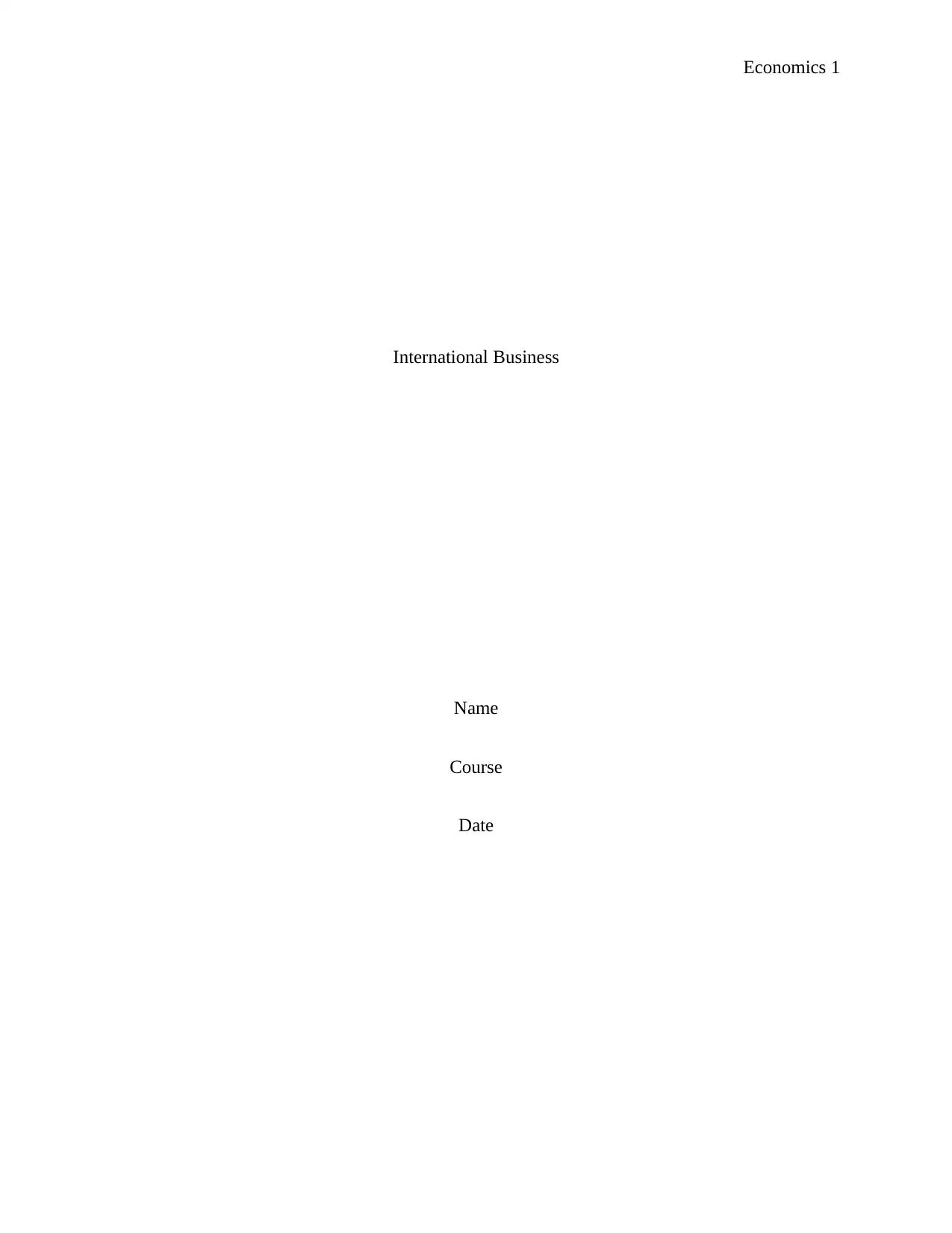
Economics 1
International Business
Name
Course
Date
International Business
Name
Course
Date
Paraphrase This Document
Need a fresh take? Get an instant paraphrase of this document with our AI Paraphraser
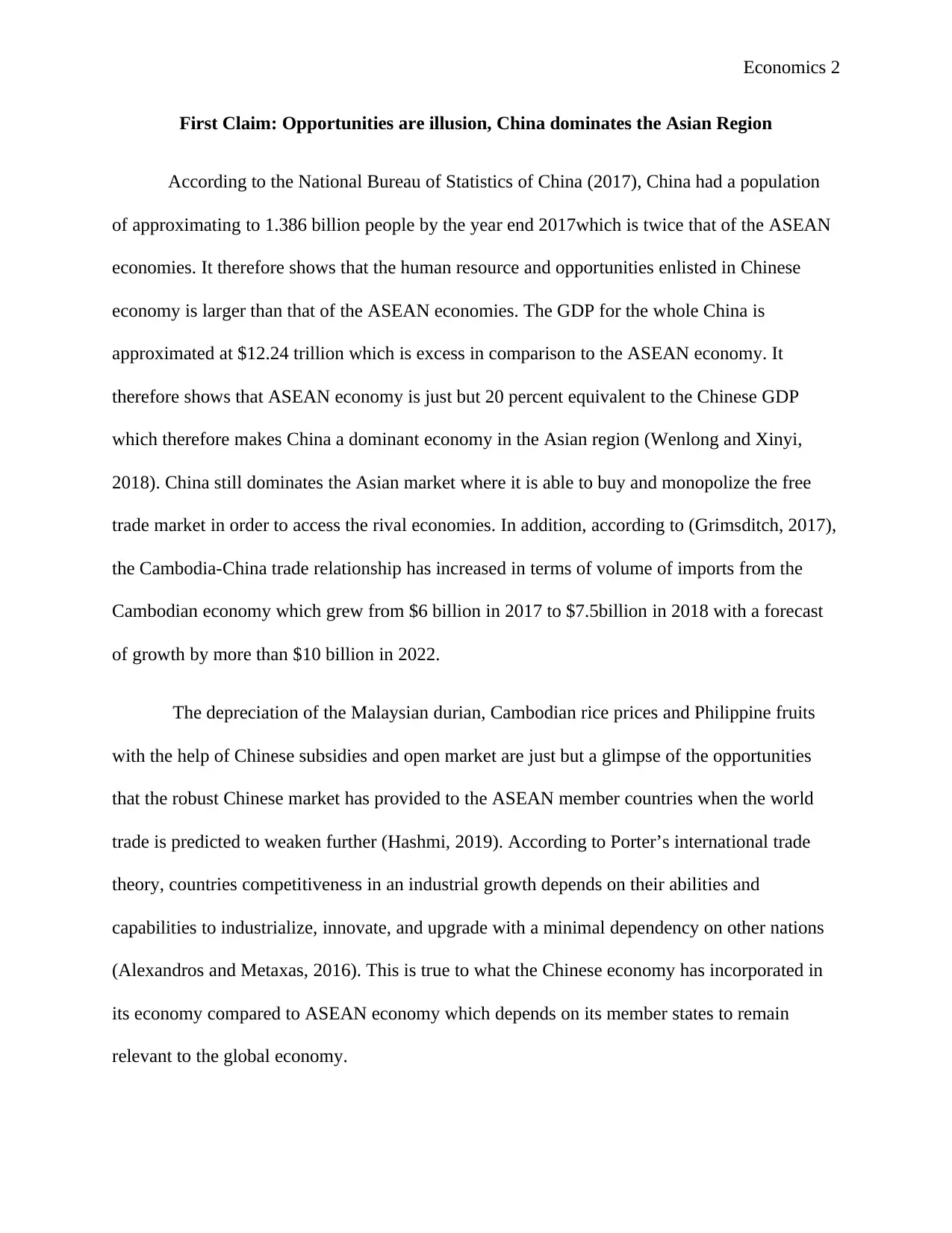
Economics 2
First Claim: Opportunities are illusion, China dominates the Asian Region
According to the National Bureau of Statistics of China (2017), China had a population
of approximating to 1.386 billion people by the year end 2017which is twice that of the ASEAN
economies. It therefore shows that the human resource and opportunities enlisted in Chinese
economy is larger than that of the ASEAN economies. The GDP for the whole China is
approximated at $12.24 trillion which is excess in comparison to the ASEAN economy. It
therefore shows that ASEAN economy is just but 20 percent equivalent to the Chinese GDP
which therefore makes China a dominant economy in the Asian region (Wenlong and Xinyi,
2018). China still dominates the Asian market where it is able to buy and monopolize the free
trade market in order to access the rival economies. In addition, according to (Grimsditch, 2017),
the Cambodia-China trade relationship has increased in terms of volume of imports from the
Cambodian economy which grew from $6 billion in 2017 to $7.5billion in 2018 with a forecast
of growth by more than $10 billion in 2022.
The depreciation of the Malaysian durian, Cambodian rice prices and Philippine fruits
with the help of Chinese subsidies and open market are just but a glimpse of the opportunities
that the robust Chinese market has provided to the ASEAN member countries when the world
trade is predicted to weaken further (Hashmi, 2019). According to Porter’s international trade
theory, countries competitiveness in an industrial growth depends on their abilities and
capabilities to industrialize, innovate, and upgrade with a minimal dependency on other nations
(Alexandros and Metaxas, 2016). This is true to what the Chinese economy has incorporated in
its economy compared to ASEAN economy which depends on its member states to remain
relevant to the global economy.
First Claim: Opportunities are illusion, China dominates the Asian Region
According to the National Bureau of Statistics of China (2017), China had a population
of approximating to 1.386 billion people by the year end 2017which is twice that of the ASEAN
economies. It therefore shows that the human resource and opportunities enlisted in Chinese
economy is larger than that of the ASEAN economies. The GDP for the whole China is
approximated at $12.24 trillion which is excess in comparison to the ASEAN economy. It
therefore shows that ASEAN economy is just but 20 percent equivalent to the Chinese GDP
which therefore makes China a dominant economy in the Asian region (Wenlong and Xinyi,
2018). China still dominates the Asian market where it is able to buy and monopolize the free
trade market in order to access the rival economies. In addition, according to (Grimsditch, 2017),
the Cambodia-China trade relationship has increased in terms of volume of imports from the
Cambodian economy which grew from $6 billion in 2017 to $7.5billion in 2018 with a forecast
of growth by more than $10 billion in 2022.
The depreciation of the Malaysian durian, Cambodian rice prices and Philippine fruits
with the help of Chinese subsidies and open market are just but a glimpse of the opportunities
that the robust Chinese market has provided to the ASEAN member countries when the world
trade is predicted to weaken further (Hashmi, 2019). According to Porter’s international trade
theory, countries competitiveness in an industrial growth depends on their abilities and
capabilities to industrialize, innovate, and upgrade with a minimal dependency on other nations
(Alexandros and Metaxas, 2016). This is true to what the Chinese economy has incorporated in
its economy compared to ASEAN economy which depends on its member states to remain
relevant to the global economy.
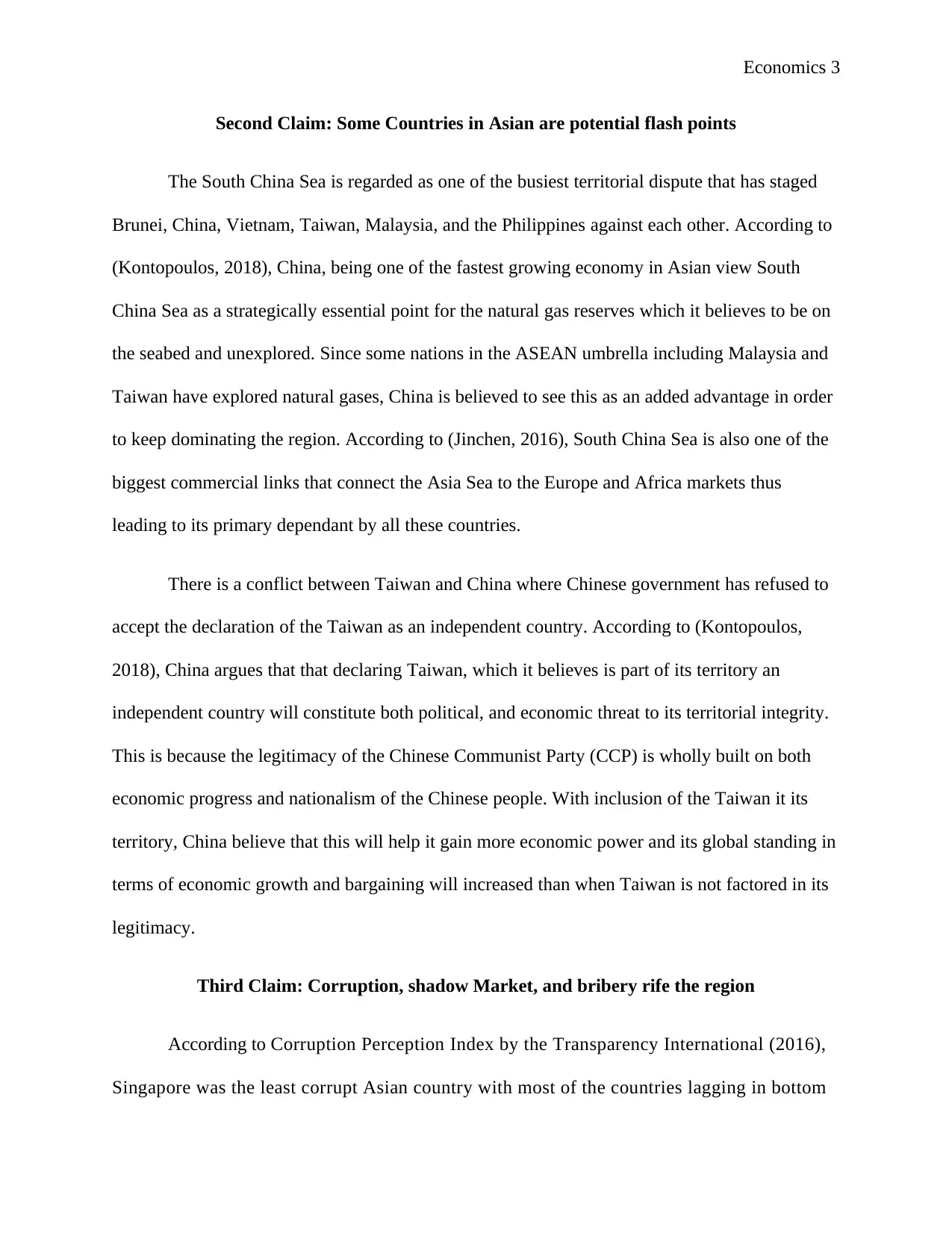
Economics 3
Second Claim: Some Countries in Asian are potential flash points
The South China Sea is regarded as one of the busiest territorial dispute that has staged
Brunei, China, Vietnam, Taiwan, Malaysia, and the Philippines against each other. According to
(Kontopoulos, 2018), China, being one of the fastest growing economy in Asian view South
China Sea as a strategically essential point for the natural gas reserves which it believes to be on
the seabed and unexplored. Since some nations in the ASEAN umbrella including Malaysia and
Taiwan have explored natural gases, China is believed to see this as an added advantage in order
to keep dominating the region. According to (Jinchen, 2016), South China Sea is also one of the
biggest commercial links that connect the Asia Sea to the Europe and Africa markets thus
leading to its primary dependant by all these countries.
There is a conflict between Taiwan and China where Chinese government has refused to
accept the declaration of the Taiwan as an independent country. According to (Kontopoulos,
2018), China argues that that declaring Taiwan, which it believes is part of its territory an
independent country will constitute both political, and economic threat to its territorial integrity.
This is because the legitimacy of the Chinese Communist Party (CCP) is wholly built on both
economic progress and nationalism of the Chinese people. With inclusion of the Taiwan it its
territory, China believe that this will help it gain more economic power and its global standing in
terms of economic growth and bargaining will increased than when Taiwan is not factored in its
legitimacy.
Third Claim: Corruption, shadow Market, and bribery rife the region
According to Corruption Perception Index by the Transparency International (2016),
Singapore was the least corrupt Asian country with most of the countries lagging in bottom
Second Claim: Some Countries in Asian are potential flash points
The South China Sea is regarded as one of the busiest territorial dispute that has staged
Brunei, China, Vietnam, Taiwan, Malaysia, and the Philippines against each other. According to
(Kontopoulos, 2018), China, being one of the fastest growing economy in Asian view South
China Sea as a strategically essential point for the natural gas reserves which it believes to be on
the seabed and unexplored. Since some nations in the ASEAN umbrella including Malaysia and
Taiwan have explored natural gases, China is believed to see this as an added advantage in order
to keep dominating the region. According to (Jinchen, 2016), South China Sea is also one of the
biggest commercial links that connect the Asia Sea to the Europe and Africa markets thus
leading to its primary dependant by all these countries.
There is a conflict between Taiwan and China where Chinese government has refused to
accept the declaration of the Taiwan as an independent country. According to (Kontopoulos,
2018), China argues that that declaring Taiwan, which it believes is part of its territory an
independent country will constitute both political, and economic threat to its territorial integrity.
This is because the legitimacy of the Chinese Communist Party (CCP) is wholly built on both
economic progress and nationalism of the Chinese people. With inclusion of the Taiwan it its
territory, China believe that this will help it gain more economic power and its global standing in
terms of economic growth and bargaining will increased than when Taiwan is not factored in its
legitimacy.
Third Claim: Corruption, shadow Market, and bribery rife the region
According to Corruption Perception Index by the Transparency International (2016),
Singapore was the least corrupt Asian country with most of the countries lagging in bottom
⊘ This is a preview!⊘
Do you want full access?
Subscribe today to unlock all pages.

Trusted by 1+ million students worldwide
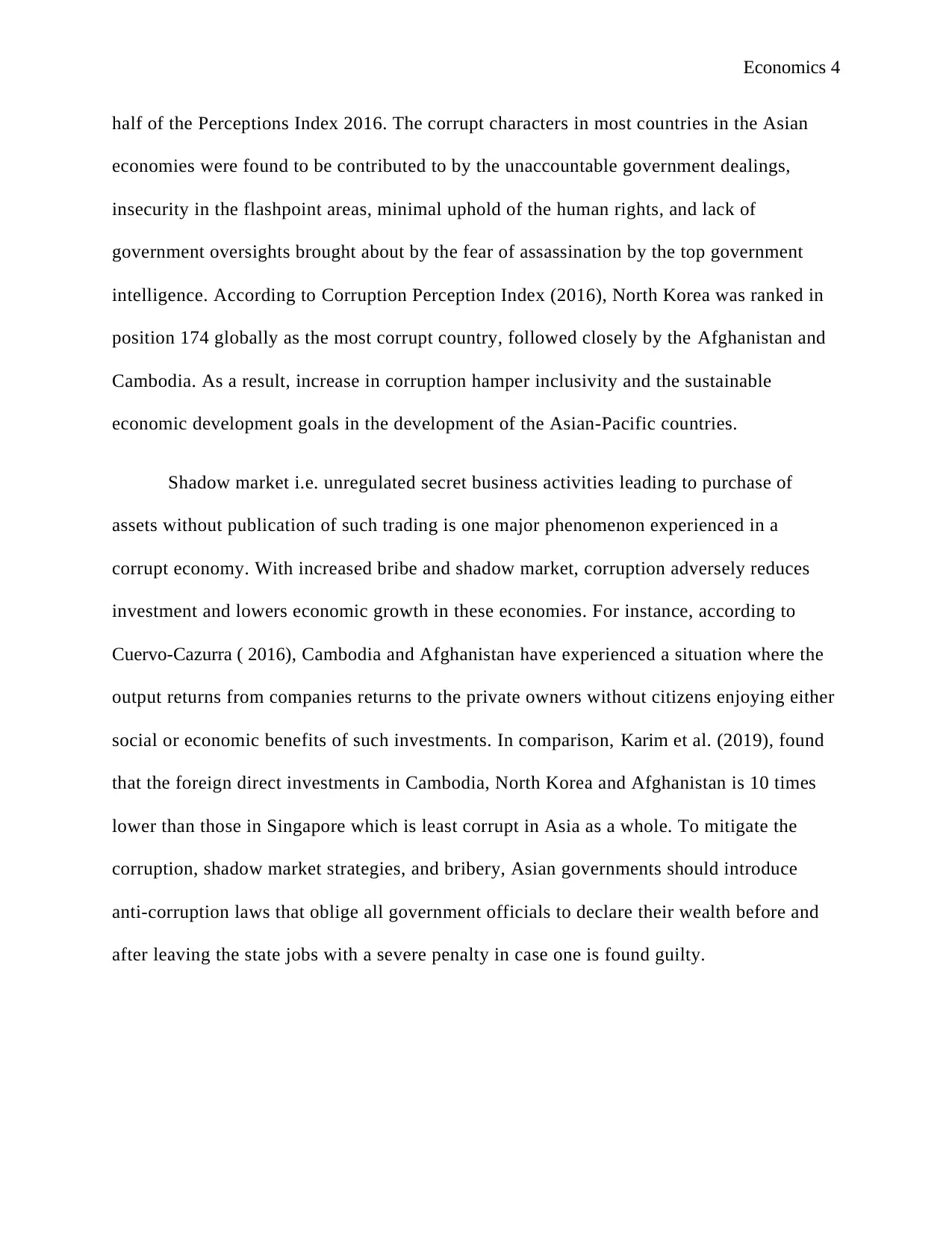
Economics 4
half of the Perceptions Index 2016. The corrupt characters in most countries in the Asian
economies were found to be contributed to by the unaccountable government dealings,
insecurity in the flashpoint areas, minimal uphold of the human rights, and lack of
government oversights brought about by the fear of assassination by the top government
intelligence. According to Corruption Perception Index (2016), North Korea was ranked in
position 174 globally as the most corrupt country, followed closely by the Afghanistan and
Cambodia. As a result, increase in corruption hamper inclusivity and the sustainable
economic development goals in the development of the Asian-Pacific countries.
Shadow market i.e. unregulated secret business activities leading to purchase of
assets without publication of such trading is one major phenomenon experienced in a
corrupt economy. With increased bribe and shadow market, corruption adversely reduces
investment and lowers economic growth in these economies. For instance, according to
Cuervo-Cazurra ( 2016), Cambodia and Afghanistan have experienced a situation where the
output returns from companies returns to the private owners without citizens enjoying either
social or economic benefits of such investments. In comparison, Karim et al. (2019), found
that the foreign direct investments in Cambodia, North Korea and Afghanistan is 10 times
lower than those in Singapore which is least corrupt in Asia as a whole. To mitigate the
corruption, shadow market strategies, and bribery, Asian governments should introduce
anti-corruption laws that oblige all government officials to declare their wealth before and
after leaving the state jobs with a severe penalty in case one is found guilty.
half of the Perceptions Index 2016. The corrupt characters in most countries in the Asian
economies were found to be contributed to by the unaccountable government dealings,
insecurity in the flashpoint areas, minimal uphold of the human rights, and lack of
government oversights brought about by the fear of assassination by the top government
intelligence. According to Corruption Perception Index (2016), North Korea was ranked in
position 174 globally as the most corrupt country, followed closely by the Afghanistan and
Cambodia. As a result, increase in corruption hamper inclusivity and the sustainable
economic development goals in the development of the Asian-Pacific countries.
Shadow market i.e. unregulated secret business activities leading to purchase of
assets without publication of such trading is one major phenomenon experienced in a
corrupt economy. With increased bribe and shadow market, corruption adversely reduces
investment and lowers economic growth in these economies. For instance, according to
Cuervo-Cazurra ( 2016), Cambodia and Afghanistan have experienced a situation where the
output returns from companies returns to the private owners without citizens enjoying either
social or economic benefits of such investments. In comparison, Karim et al. (2019), found
that the foreign direct investments in Cambodia, North Korea and Afghanistan is 10 times
lower than those in Singapore which is least corrupt in Asia as a whole. To mitigate the
corruption, shadow market strategies, and bribery, Asian governments should introduce
anti-corruption laws that oblige all government officials to declare their wealth before and
after leaving the state jobs with a severe penalty in case one is found guilty.
Paraphrase This Document
Need a fresh take? Get an instant paraphrase of this document with our AI Paraphraser
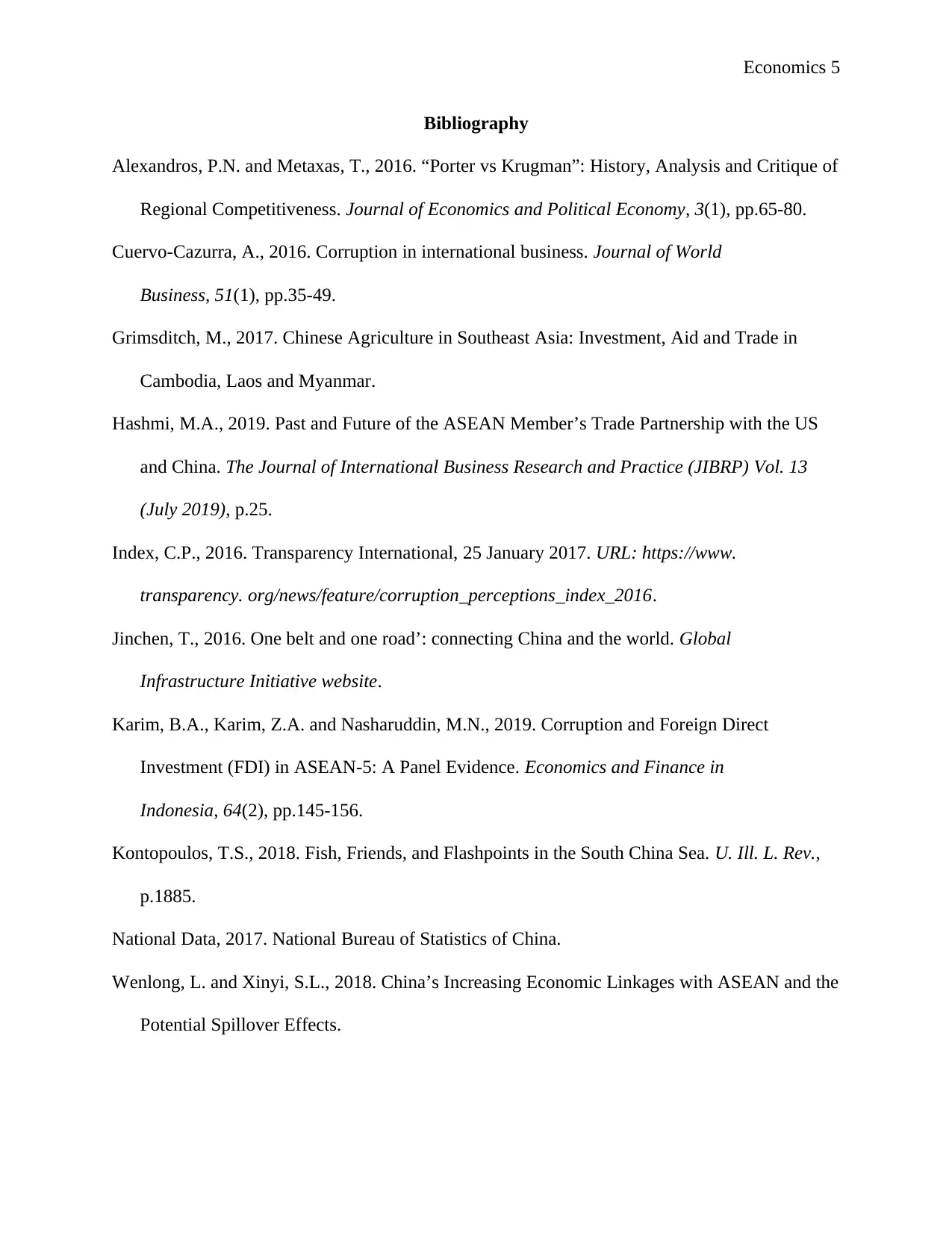
Economics 5
Bibliography
Alexandros, P.N. and Metaxas, T., 2016. “Porter vs Krugman”: History, Analysis and Critique of
Regional Competitiveness. Journal of Economics and Political Economy, 3(1), pp.65-80.
Cuervo-Cazurra, A., 2016. Corruption in international business. Journal of World
Business, 51(1), pp.35-49.
Grimsditch, M., 2017. Chinese Agriculture in Southeast Asia: Investment, Aid and Trade in
Cambodia, Laos and Myanmar.
Hashmi, M.A., 2019. Past and Future of the ASEAN Member’s Trade Partnership with the US
and China. The Journal of International Business Research and Practice (JIBRP) Vol. 13
(July 2019), p.25.
Index, C.P., 2016. Transparency International, 25 January 2017. URL: https://www.
transparency. org/news/feature/corruption_perceptions_index_2016.
Jinchen, T., 2016. One belt and one road’: connecting China and the world. Global
Infrastructure Initiative website.
Karim, B.A., Karim, Z.A. and Nasharuddin, M.N., 2019. Corruption and Foreign Direct
Investment (FDI) in ASEAN-5: A Panel Evidence. Economics and Finance in
Indonesia, 64(2), pp.145-156.
Kontopoulos, T.S., 2018. Fish, Friends, and Flashpoints in the South China Sea. U. Ill. L. Rev.,
p.1885.
National Data, 2017. National Bureau of Statistics of China.
Wenlong, L. and Xinyi, S.L., 2018. China’s Increasing Economic Linkages with ASEAN and the
Potential Spillover Effects.
Bibliography
Alexandros, P.N. and Metaxas, T., 2016. “Porter vs Krugman”: History, Analysis and Critique of
Regional Competitiveness. Journal of Economics and Political Economy, 3(1), pp.65-80.
Cuervo-Cazurra, A., 2016. Corruption in international business. Journal of World
Business, 51(1), pp.35-49.
Grimsditch, M., 2017. Chinese Agriculture in Southeast Asia: Investment, Aid and Trade in
Cambodia, Laos and Myanmar.
Hashmi, M.A., 2019. Past and Future of the ASEAN Member’s Trade Partnership with the US
and China. The Journal of International Business Research and Practice (JIBRP) Vol. 13
(July 2019), p.25.
Index, C.P., 2016. Transparency International, 25 January 2017. URL: https://www.
transparency. org/news/feature/corruption_perceptions_index_2016.
Jinchen, T., 2016. One belt and one road’: connecting China and the world. Global
Infrastructure Initiative website.
Karim, B.A., Karim, Z.A. and Nasharuddin, M.N., 2019. Corruption and Foreign Direct
Investment (FDI) in ASEAN-5: A Panel Evidence. Economics and Finance in
Indonesia, 64(2), pp.145-156.
Kontopoulos, T.S., 2018. Fish, Friends, and Flashpoints in the South China Sea. U. Ill. L. Rev.,
p.1885.
National Data, 2017. National Bureau of Statistics of China.
Wenlong, L. and Xinyi, S.L., 2018. China’s Increasing Economic Linkages with ASEAN and the
Potential Spillover Effects.
1 out of 5
Related Documents
Your All-in-One AI-Powered Toolkit for Academic Success.
+13062052269
info@desklib.com
Available 24*7 on WhatsApp / Email
![[object Object]](/_next/static/media/star-bottom.7253800d.svg)
Unlock your academic potential
Copyright © 2020–2025 A2Z Services. All Rights Reserved. Developed and managed by ZUCOL.





